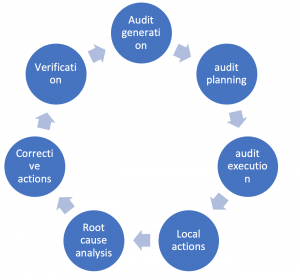The Opportunity Anglian Water, a leading water services company in the UK, wanted support in…

Quick Glance Case Study: Quality Management System Audit
“The lean review has enabled us to achieve a clear, concise, dynamic internal audit programme, fully tailored to the business needs”
After completing a ChangeWise Lean Practitioner training course, one candidate submitted the following work-place project to gain their qualification to LCS Level 1c.
The Business Challenge
Our team was responsible for conducting an internal quality audit for our integrated Quality Management System (QMS).
However, the process did not have clear expectations around outputs, or guidance regarding how or why we conduct the audit visits.
Over a two-year duration, we had already completed three major overhauls of the internal audit programme. However, these reviews had failed to make it past the design phase, resulting in a non-conformance from the external assessor of the QMS. In addition, this led to team frustration, lack of effective performance management, reduction in the team’s presence and reputation in the business, and lack of awareness regarding the role of the team.
A lean review was required in order to achieve a clear, concise, dynamic internal audit programme, fully tailored to the business needs, addressing high risk areas, reducing raised non-conformities and improving compliance to the QMSs and external regulators.

Photo by Emma Van Sant on Unsplash
Key people involved from client site
Representatives from the Senior Leadership Team, Management Board, relevant external auditing bodies and the Risk & Systems team were involved on the review.
Lean Methodology Employed
DMAIC (Define, Measure, Analise, Improve, Control)
Various Lean methodologies were used including, VoC, Stakeholder Matrix, SIPOC, Current State Mapping, Value Analysis, Future State Mapping, Brainstorming, Ishikawa Diagrams and Data Collection Plans.
Lean Activities and Findings
The team created a Stakeholder Matrix to identify both the internal and external customers for the review. This included the internal management board, relevant external auditing bodies and the Risk & Systems team who all require objective evidence and assurance in the application of the QMSs.
Our next step was to create a SIPOC for the high-level current state, followed by more detailed current state mapping and value analysis to understand more about the constraints within our process. These activities revealed the lack of current structure, method and closing loop behind the way we selected who to audit, or how the outcome of the audit was escalated. We also lacked a process for root cause investigation of issues, or any form of reporting/trending on themes of potential risks.
In the previous year, 21 audits were conducted by a team of 9 as part of the internal audit programme and 65 non-conformances were raised by our external auditors throughout our QMSs.
We used Root Cause Analysis techniques to help us understand more about the issues. There was a key theme regarding business buy-in and lack of support for audits. This was largely driven by the current process’s lack of structure, follow-up, ownership and absence of agreed outputs.
Benefits & Outcomes
In order to establish a baseline and agree future key indicators for the internal audit process, we created a data collection plan. From this we agreed the following future state success measures:
- Number of audits per Coordinator
- Number of Management system audits
- ISO coverage within the business
- Number of teams/business units covered by the internal audit programme Mileage reduction
- Number & Severity of external non-conformances raised
We also introduced measures to ensure standards were sustained:
- Two weekly meetings with the team of coordinators to discuss progress, bottlenecks and share best practice
- Creation of a Team Dashboard and Business Dashboard to track progress
It was also agreed that a Governance Model would be introduced and owned by the Risk & Systems Management team
To agree ‘one best way’, we held a brainstorm session to generate ideas, solution selection and action planning for the future state.
The most prominent idea was to create a ‘one stop shop’ tool where all the information (end2end) would be kept, in order to provide a clear visible programme, with the ability to manage both team performance as well as business engagement and compliance.

To ensure the success of the future state, visual tools such as a ‘How it Works’ tab would be built into the system, along with root causes analysis training for teams to help drive a continuous improvement mindset.
In addition, we created an implementation plan for communication to stakeholders and the senior leadership team.
The new process will enable:
- Increased buy in from front line managers, making QMS more effective.
- Trend data for risks which would allow us to be proactive instead of reactive
- Useful data/tools to help steer external audit programmes
- Streamlined team management
- A quality driven mindset, guiding the business towards the ‘QMS way’
- More efficient time and mileage due to removing wasted visits
- Increases resilience within the business
- Optimum business performance, via the application of QMS
- Increased job satisfaction
- Increased ability within teams to facilitate solutions, driving empowerment
- Improvement of the team’s standing as experts in QMS
- Steering and support for the external audit programme
- Increased job satisfaction for R&S Coordinators

Photo by Marek Studzinski on Unsplash
In Summary
The lean review has enabled us to achieve a clear, concise, dynamic internal audit programme, fully tailored to the business needs, addressing high risk areas, reducing raised non-conformities and improving compliance to the QMSs and external regulators.
Interested in looking at how Lean can help to reduce risk whilst improving customer satisfaction and reducing costs within your organisation? Contact us at info@changewise.co.uk and let’s talk about how we can help.
ChangeWise believes employee engagement is the foundation for successful Change. Training and coaching your people to use simple continuous improvement techniques will enable your organisation to continuously adapt and stay ahead in a constantly changing and challenging environment.
For updates and interesting Lean Change insights, connect with us on LinkedIn.



